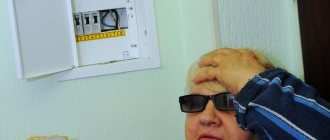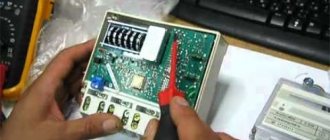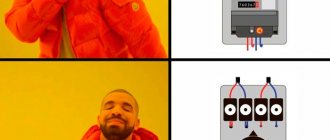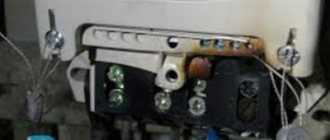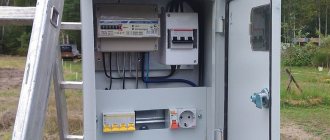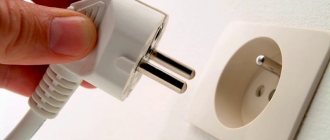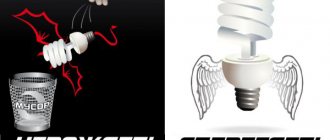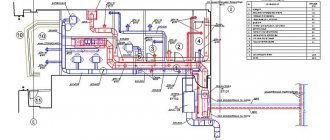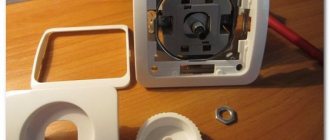Residents of city apartments and owners of private real estate have to face the problem when the electricity meter fluctuates a lot. At the same time, the number of consumers did not increase, and the intensity of their exploitation remained at the same level. Accident in such coincidences is excluded; all events have reasons and technical grounds. To figure out why the electric meter is shaking a lot, you need to study the causes of this phenomenon and how to eliminate them. This will avoid large bills for energy that people did not use.
Reasons for distortion of real electric meter readings
When replacing an old meter with a new electronic one, the difference in readings can exceed up to 20-30%.
An increase in electricity consumption can have objective and subjective prerequisites.
Conventionally, the reasons for overspending can be divided into the following groups:
- Seasonal. These include a longer operating period for lighting fixtures in winter, and more time is spent heating cold water in the boiler. In an effort to warm up, a person drinks more tea and takes hot baths. In the summer heat, air conditioners are turned on, chest freezers and refrigerators are turned on more often.
- Replacement of equipment. Devices with disks do not respond to light loads. In contrast, electronic devices count all types of consumption that exist in the room. The difference can reach up to 20-30%.
- Counter quality. Energy companies purchase both domestic and foreign equipment manufactured in China. In the second case, the consumer is dealing with low-quality products that have unstable parameters.
There are a number of factors that negatively affect the correct operation of the meter. They are determined by intent, which has its own specific goals.
Types and rules for choosing an electric current converter
Transformer equipment that reduces current (CT) is classified according to various characteristics, including conversion ratio. This equipment is required if the facility consumes power that is several times greater than the capabilities of a conventional node.
The CT converts the current to a level that allows you to connect conventional one- or three-phase electricity meters for monitoring and create a line protection system.
Classification
By installation method
According to this principle, CTs are divided into:
- supporting (installed on the surface);
- pass-through (attached to the busbar);
- tire (attached to the tire);
- built into power electric current systems;
- detachable (installed on cables).
By type of insulation
An electric current transformer can be:
- with epoxy resin or special varnish;
- in a plastic case;
- with solid insulation made of porcelain, bakelite. hard plastic;
- with a viscous composition (oil);
- filled with gas;
- with oil-paper insulation.
What parameters to consider
To calculate the readings of an electric meter with current transformers, the transformation ratio is important. It can be single-stage or cascade (multi-stage). The last type of CT is distinguished by the presence of several secondary windings and a large number of turns in the primary winding.
It is not advisable to buy a TT with too high a transformation level. With such a choice, you will have to install a counter at the receiving input. More popular are converters with one coefficient, which do not change the reading during operation. When using them, the problem of how the readings of an electricity meter connected through current transformers are calculated is easier to solve.
Calculation of electricity using a meter with current transformers can only be carried out if the transformation ratio is known. It must be indicated in the technical documentation with which the TT was sold and on the body. If you suspect inaccuracies in the displayed figures, you can calculate the coefficient yourself.
To calculate the ratio, you need to connect the converter to the electric current that creates a short circuit in the secondary winding and measure how many amperes there are in it.
Transformation ratio is the ratio of the values of the supplied electric current and the current passing in the secondary winding.
For example, if a short circuit is caused by 150 A, on the secondary winding 5 A, the effective coefficient is 30. This is a more accurate value than the nominal value, which is determined by the rated electric current of the primary and secondary windings. The result of calculating electric meter readings with current transformers is more accurate.
Changes in readings when trying to influence the meter
Installing a magnet on the meter negatively affects the operation of the device.
When the electricity meter winds a lot, the reason for this may be its incorrect calibration. It is produced on the basis of the energy company after receiving a batch of products or before its installation at consumers. Incorrect values may be set either accidentally due to personnel error or deliberately in order to obtain additional profit. This is illegal, but also unprovable, since the device can only be checked by specialists from the supplier. It is prohibited to independently break the seal and submit the metering device to an independent laboratory.
In turn, a private individual tries to turn the situation in his favor through various options for influencing the counter:
- Magnet installation. This device does not always give the desired effect, since it must be correctly installed on the body. In addition, if a counterfeit is used, the meter can wind up twice or three times the nominal value and even fail. All this is fraught with major material damage.
- Wheel braking in an inductive device. To do this, a thin hole is drilled in its body into which a wire, needle or awl is inserted. Before the inspector’s visit, the insert is removed, the hole is sealed with plasticine and masked with dust. The method is effective, but dangerous in all respects.
All attempts to influence the metering device are a violation of the agreement concluded by the parties and the current legislation. If they are detected, a large fine is imposed on the property owner.
How to make a left socket in a private house
This method is often used when you need to connect a welding machine.
The “packet” will help reduce your performance! There is another option for connecting grounding without damaging the electrical wiring. In this case, the main role is given to the standard package switch, which is placed in front of the metering device.
To detect such a connection, it is necessary that the wire coming from the pole be visible from the street along its entire length - then the additional wiring thrown over them can be seen with the naked eye.
If the house is located deep enough in the yard and the insulators are hidden from prying eyes, then you only need to visually inspect the wires for burnt marks that will be created by thrown wires. To get rid of them, some craftsmen make clamps that attach to the wire, and when the inspector visits, they are removed within a few minutes.
In what cases does the electricity meter overestimate the readings?
Approximate diagram of the power of various electrical appliances
The main feature of electronic metering devices is their sensitivity. Unlike induction analogues, they record the operation of all indicators installed in household appliances. Since it is not disconnected from the network, up to 50 kW can be supplied per month, even if no one lives in the apartment.
Another factor influencing the increase in readings is the parameters of the supplied energy. Devices are calibrated according to the electricity level indicated in the product data sheet.
The electricity meter increases more when one of the following indicators changes:
- Voltage. The electrical circuit of the device is designed for 230 V. This is an ideal that is rarely met. In most cases, the signal varies between 180-210 V. Because of this, active load consumers (elements of boilers and stoves) heat much worse and take longer. The difference in energy expended can be fivefold.
- Frequency. Here everything is similar to voltage - the higher the frequency, the lower the readings. However, not always - with strong deviations, a software failure may occur, which leads to larger errors in calculations.
- Power. Apartments use devices that produce reactive power during operation, as a result of which part of the accounted electricity flows back into the network.
A modern antimagnetic meter is a precise device programmed for certain indicators. Any deviations lead to malfunctions in its operation.
Hidden cheats - identifying the source of problems
Even if your meter is working properly, it may waste extra kilowatts, for which you will have to pay. One of the hidden reasons is a decrease in voltage in the electrical network. This problem becomes global during the period of mass switching on of electrical appliances, for example, air conditioners or heaters. Household appliances reduce efficiency and network voltage below 220 V. For example, consider a washing machine. On average, 0.19 kW is consumed to wash 5 kg of laundry. But this is only according to the passport. In practice, energy consumption exceeds 0.25 kW. And so with almost all devices. The result is different indicators of electricity consumption of the same equipment during certain periods of time.
Taking readings
To find out about a possible low voltage, call your utility service technician and ask to check your home's utility meter. The memory of the electronic device stores information on readings over a long period of time, so it is not difficult to track and identify the problem. If after the examination it turns out that the voltage was nevertheless reduced, you have the right to write a complaint to Rospotrebnadzor and the Society for the Protection of Consumer Rights, because this is a serious offense. In addition to paying for extra kilowatts of electricity, the service life of household appliances is reduced.
Don't forget about the power supply to the electric meter. In some models, electricity consumption can reach 4 W/hour or 3 kW/month. Abroad, network services pay for this, but in our country, we do.
Therefore, if you have any doubts, call the meter checking service, which should check the real light readings and those that you write off from the device. The entire verification process is carried out under your control.
Features of electricity meters
Electronic electricity meters
Based on the principle of operation, products are divided into the following categories:
- Mechanical (induction). Current and voltage coils are installed in the housing. When current passes through them, a magnetic field is created that rotates the disk, connected through gears to a digital sensor. The rotation speed is proportional to the power consumption. The advantage of the devices is their reliability and affordable price. The disadvantage is that they do not record low consumption.
- Electronic. They measure the parameters of the passing current directly, storing them in memory. After which the sensor is screwed on. They are small in size, highly accurate and protected from external interference. The disadvantages are sensitivity to electricity parameters and high cost.
To avoid losses, energy companies are making large-scale purchases and replacing mechanical devices with electronic ones.
Cost of a new meter
Power supply of objects
And an additional magnet means additional braking. To simply supply direct current through current coils, two meters connected to the same phase are required. You can, for example, cooperate with a neighbor, or, under any pretext, arrange an additional meter.
The secondary winding of the transformer should produce a small voltage of 5 V, such that the current is equal to twice the rated current of the meter (this is selected experimentally). The inductor is optional; it allows you to meter electricity separately across circuits, and also smoothes out the ripple of the rectified current. The number of turns should be small to avoid saturation of the core. In this way, it is possible to reduce the counter stroke by 30%.Characteristic features. If the meters are located in an apartment or private house, then it is almost impossible to detect the method.
The most common causes of failures
One of the reasons for failure of the electric meter readings is wear and tear of the equipment.
The most common causes of failures in the meter readings are the following:
- depreciation of equipment;
- incorrect wiring made in the input panel;
- failure of some parts due to exposure to low or high voltage;
- prolonged work with increased load, which leads to overheating and combustion of some elements;
- an attempt to independently influence the device with a strong magnetic field, causing a violation of the correctness of its circuit.
If none of these events occurred, the source of the problem may lie in a manufacturing defect or external influence.
How to check the serviceability of the system without specialists - counting impulses
If you do not trust specialists and want to check the correct operation of your meter yourself, we suggest checking the number of declared electronic pulses. Let's look at an example using the Energomer model, which receives frequent complaints. To do this, find the designation on the device - “A=3200 imp/(kW*h)”. Instead of the number 3200 there may be another indicator. This is the number of pulses that make up 1 kW/hour.
If your device counts incorrectly, then 1 kW/hour will burn up in 1600 pulses. Thus, the hourly norm occurs in half an hour, and the electricity indicators double. When checking for malfunction of the device, pay attention to the extreme number of readings, which read not kilowatts, but hundredths (0.01 kW). After scrolling every hundredth of a beat, a click is heard and the counter scrolls by one beat. A defective device will change indicators faster. To check the authenticity of the numbers, take a timer. One LED flash, which is located next to the inscription imp/(kW*h), corresponds to one pulse. Count how many of these impulses you get per minute and multiply this figure by 60 minutes. With a total load of devices equal to 1 kW/hour, the pulse indicators should converge with the norm specified by the manufacturer.
What to do if the readings are too high
If the meter readings increase, it is necessary to check the electrical panel for illegal connections.
If there is an increase in the usual readings of electricity consumption, the following actions should be taken:
- turn off household appliances that are used occasionally;
- descale heating elements in the boiler and washing machine;
- check the common panel for illegal connections;
- disassemble and inspect sockets located on adjacent walls for the same purpose;
- install a meter that takes into account reactive power.
To make sure that the device really overestimates the amount of energy used, you need to turn off all consumers and measure how much of it will be spent to operate the source over a certain period of time. As a load, you can use a 100 W lamp, a boiler, a burner or a boiler. If the readings diverge by more than 20%, the device is not operating properly. In this case, you should buy a new one, have it checked in an independent laboratory, and submit an application for a replacement meter to the management company. Its employees must respond to the appeal within the time limit required by law.
Basic classification of transformer current devices
This is a very large group of devices that can be divided into different groups. Among the most common:
- Classes by installation method:
- Surface-mounted or pole-mount transformers.
- Feedthroughs, which are attached to the busbar and act as an insulator.
- Busbars attached to a busbar that serves as the primary winding.
- Built-in, installed power-type devices, as well as tank switches.
- Detachable, quickly installed on cables and not requiring disconnection of the circuit.
Current transformer: a) - current transformer device.
- Classes according to typological features of insulation:
- With cast insulation, which uses epoxy resin and special insulating varnishes.
- Housed in a plastic housing.
- Having highly effective solid polymer, bakelite or porcelain insulation.
- Isolated with viscous compounds with enveloping properties.
- Oil, isolated with special compounds.
- Gas-filled, used for high and ultra-high voltages.
- As well as mixed paper-oil insulation with an impressive efficiency resource.
Current transformers with cast insulation: a) - multi-turn, b) - single-turn, c) - busbar
Basic requirements for devices
Any electrical appliances, regardless of where they are installed, are subject to the same requirements:
- The device must be certified, otherwise its use is impossible.
- After the replacement procedure is completed, the new device is registered. The owner of the product and a representative of the energy company must be present.
- You can start using the meter only after it has been sealed by a representative of Energosbyt, who issues written permission to do so. In this case, the seal must already have one state inspection seal.
- The owner is returned one copy of the acceptance certificate indicating the device number. To avoid misunderstandings, it is better to immediately check whether the number on the act matches the one on the meter.
- Regardless of which meter was chosen, it is installed at a height of 1.7 meters in a dry place accessible for maintenance. The device can hang on the wall or be hidden inside an electrical cabinet. It is best if the ambient temperature is not lower than 0 degrees.
- The meter is connected only with a single wire, without any connections. In the case when during replacement it is necessary to move the wire to another place, it is allowed to cut the wires to extend them. The connection sections are connected via an automatic machine. It is closed in a box and also sealed along with the meter.
These are the basic rules that every electricity consumer must follow.
Classification
Electricity meters are divided into single-phase or multiphase; such devices are used for networks where there may be alternating voltage.
For example, a single-phase meter, which is installed in almost all residential premises, functions only in the range from 220 to 230 V, while three-phase ones also measure voltage in the range from 220 to 400 V.
Detailed meter classification scheme Many energy companies provide the opportunity to save on electricity by installing a multi-tariff meter. Such devices have two or more independent scales, the transition between them is carried out at a certain time.
Typically, at night, 1 kW of electricity is much cheaper, but the volume of its consumption is also greatly reduced. To save money, you can program some devices, such as a washing machine or dishwasher, to operate at night.
There are 3 types of counters:
- induction;
- electronic;
- contactless.
Where to go to apply
As soon as you are sure that the meter is not working, the first thing you need to do is call the energy supply company and report what happened. If a non-working electric meter in an apartment poses even the slightest danger: it hums, smokes or smells burnt, be sure to turn off the voltage at the input. After this, you will need to come to the organization yourself and ask for a sample application, after writing which the energy sales representatives should come to your home (the approximate date and time should be told right away).
On site, the inspector must draw up a report on the malfunction of the electricity meter. To do this, he inspects the device for third-party interference in its design, takes the last readings and then draws up a document. When drawing up the report, be sure to clarify what reason for the breakdown the inspector is writing down, so that later disagreements and ensuing problems do not arise.
Important! Never try to repair the electric meter yourself! Even if you find that the cause of the breakdown is poor contact or its absence, you should know that opening the seal will result in a considerable fine.
According to the standard
If an electric meter is not installed, the consumer pays for the supply of resources according to current standards. Standard indicators and tariffs are approved by local authorities, taking into account the costs of production and transmission of electrical energy, as well as the individual characteristics of the region that affect the cost of resources.
If the absence of an individual meter is explained by the impossibility of installing it for technical reasons, the calculation is performed using the following formula:
P = k × N × T, in which
- P – monthly payment amount;
- k – the number of officially registered residents in the specified living space;
- N – consumption standards established in the region;
- T – the value of the tariff that determines the cost of one kilowatt-hour.
If there are no technical reasons why it is impossible to install an electric meter, an increasing coefficient is additionally included in the formula in addition to the indicated multipliers. Its use is explained by the fact that the authorities are trying to interest owners in installing individual metering devices.
The number of residents is determined according to official registration data. But if, during the inspection, representatives of the management company identify additional persons in the specified living space, the payment amount will be calculated taking into account unregistered residents.
